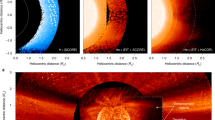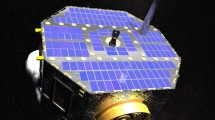Abstract
One of the important astrophysical problems is the determination of the abundance of helium isotopes 3He and 4He in different regions of the Universe, because this abundance can reflect its history by pointing to the intensity of various possible processes of the creation and decay of light elements. This paper describes the method and results of the determination (for the first time performed by a direct method) of the helium isotopic abundance in the local interstellar medium surrounding the Solar system. The experiment was carried out on the manned Mir space station by long-term space exposure of samples of metal foil with their subsequent recovery to the Earth and detailed laboratory mass-spectrometric analysis. As a result, we succeeded in obtaining an estimation of the 4He concentration (about 7.5 × 10–3 cm–3) and the isotopic ratio 3He/4He (about1.7 × 10–4) for the local interstellar medium.
Similar content being viewed by others
REFERENCES
Charbonnel, C., Mixing in Stars and the Evolution of the 3He Abundance, Space Sci. Rev., 1998, vol. 84, p. 199.
Tosi, M., Evolution of D and 3He in the Galaxy, The Light Elements and Their Evolution-IAU Symposium, vol. 198 of ASP Conference Series, La Silva, L. Spit, M., and de Medeiros, J., Eds., 2000.
Geiss, J., Primordial Abundances of Hydrogen and Helium Isotopes, in Origin and Evolution of the Elements, Prantoz, N., Kandioni-Flam, E., and Gasse, M., Eds., Cambridge: Cambridge Univ. Press, 1993, p. 89.
Gloeckler, G. and Geiss, J., Measurement of the Abundance of Helium-3 in the Sun and in the Local Interstellar Cloud with SWICS on ULYSSES, Space Sci. Rev., 1998, vol. 84, p. 275.
Balser, D., Bania, T., Rood, R., and Wilson, T., The 3He Abundance in Planetary Nebulae, Astrophys. J., 1997, vol. 483, p. 320.
Galli, D., Stanghellini, L., Tosi, M., and Palla, F., 3he in Planetary Nebulae: A Challenge to Stellar Evolution Models, Astrophys. J., 1997, vol. 477, p. 218.
Kurt, V.G., Mironova, E.N., Berteau, J.-L., and Dalodier, F., Helium Atoms in Interstellar and Interplanetary Media: III. Temperature and Velocity of the Interstellar Wind, Kosm. Issled., 1984, vol. 23, no. 2, pp. 225–238.
Witte, M., Banaszkiewicz, M., and Rosenbauer, H., Recent Results on the Parameters of the Interstellar Helium from the ULYSSES/GAS Experiment, Space Sci. Rev., 1996, vol. 78, p. 289.
Bueler, F., Bassi, M., Bochsler, P., et al., First Detection of 4He in a Sample of Interstellar Neutral Gas Collected onboard Mir Station, Astrophys. Space Sci., 2000, vol. 274, p. 19.
Salerno, E., Bueler, F., Bochsler, P., et al., Direct Measurement of 3He/4He in the LISM with the COLLISA Experiment, in Solar and Galactic Composition, AIP Conf. Proceed., Wimmer-Schweingruber, R.F., Ed., Woodbury, NY, 2001.
Baranov, V.B. and Krasnobaev, K.V., Gidrodinamicheskaya teoriya kosmicheskoi plazmy (Hydrodynamic Theory of Space Plasma), Moscow: Nauka, 1977.
Geiss, J., Eberhardt, P., Signer, P., Buchler, F., and Meister, J., Apollo 11 and 12 Solar Wind Composition Experiments: Fluxes of He and Ne Isotopes, J. Geophys. Res., 1970, vol. 75, p. 5972.
Buehler, F., Axford, W.I., Chivers, H.J., and Marbi, K., Helium Isotopes in the Aurora, J. Geophys. Res., 1976, vol. 81, p. 111.
Filleux, C., Moergeli, M., Stettler, W., et al., Trap** of Low-Energy Helium Ions in Polycrystalline Al and Pt and in BeO and Anodic Al2O3 Films at Room Temperature, Radiation Effects, 1980, vol. 46, p. 1.
Yermolaev, Yu.I., Strong Geomagnetic Disturbances and Their Correlation with Interplanetary Phenomena during the Operation of the INTERBALL Project Satellites, Kosm. Issled., vol. 39, no. 3, pp. 324–331.
Mahaffy, P., Donahue, N., Altreya, S., et al., Galileo Probe Measurements of D/H and 3He/4He in Jupiter's Atmosphere, Space Sci. Rev., 1998, vol. 84, p. 251.
Bodmer, R. and Bochsler, P., The Helium Isotopic Ratio in the Solar Wind and Ion Fractionation in the Corona by Inefficient Coulomb Drag, Astron. Astrophys., 1998, vol. 337, p. 921.
Author information
Authors and Affiliations
Rights and permissions
About this article
Cite this article
Zastenker, G.N., Agafonov, Y.N., Eismont, N.A. et al. Method and Results of Direct Measurement of the Interstellar Neutral Helium Abundance and Isotopic Composition. Cosmic Research 40, 347–357 (2002). https://doi.org/10.1023/A:1019894311608
Issue Date:
DOI: https://doi.org/10.1023/A:1019894311608




